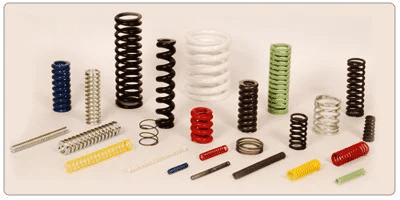Product Description:
Accurate Helical Springs Pvt. Ltd.We manufacture compression springs from Wire dia 0.1 mm to 12.5 mm.
A type of spring designed to compress and become smaller when pressed with compressive load. Compression spring normally refers to a coil compression spring.
The ends can be ground flat so that force is applied squarely to each end of the spring, reducing the tendency to buckle, or to accommodate accurate seating requirements and a reduced solid height that may be imposed by particular applications. Compression Spring Design Hints 1. Compression springs are the easiest type to make. Can be made more rapidly and accurately than other types and should be used in preference to other types wherever possible.2. Avoid using open ends or open and ground ends. Such springs usually tangle when shipped. They also buckle when deflected.3. Use closed ends only and avoid grinding whenever possible, especially on light wire sizes under 0.60 mm or where a large spring index Om/d prevails such as 13 or larger. Grinding is a slow and expensive operation.4. Use conical springs when a short, solid height is needed and to reduce buckling.5. Avoid using conical, barrel shaped, or other special shapes, where a standard helical spring could be used.6. Design springs with a reasonably safe stress when compressed solid so that they may be adaptable to other installations.7. Do not specify coiling right hand or left hand if it is not important. Specify right hand if it must be threaded onto a bolt. If a spring is used inside another, one spring should be wound left hand and the other right hand to avoid meshing of the coils.8. Specify a force with a tolerance at an exact compressed height rather than a definite deflection. Testing instruments are designed to test force at specified heights. Specifying two or more force automatically determines a rate and should be avoided if possible, but is often necessary on important springs. The rate equals the difference in the two forces divided by the amount of deflection between those forces.9. Three springs standing side by side will have a rate and solid force three times that of one spring.10. The outside diameter of a compression spring increases and the outside diameter of an extension spring decreases when deflection occurs.11. Avoid designing spring with spring index Dm/d below 4 and above 5
 View All
View All





